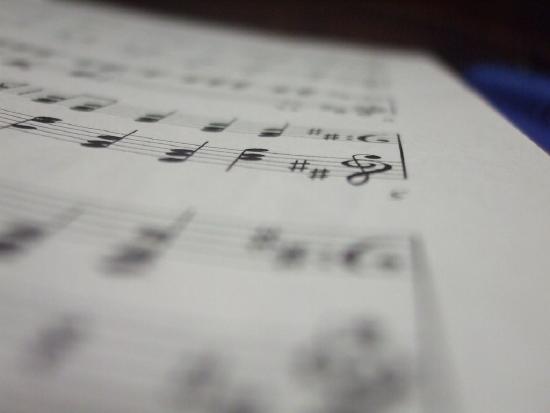1.1: What is Music?
- Page ID
- 165573
What is Music?

"Sheet music." by jonisanowl is licensed under CC BY-SA 2.0.
Though it might be somewhat odd to begin a text on music with the age-old question "what is music?" it's a good exercise for anyone to engage in. It also tends to be the one question that simultaneously stumps musicians, while also angering them! Ask a musician "what is music?" and you'll more than likely get an eye roll, and a response that sounds like "I don't want to do this right now."
How would you define music? Go ahead, and think about it for a few seconds. What does all music have? What does it not have? Where do we hear it?
Jot your responses down on a sheet of paper, or type them in your phone (I know you have it near you). When you're done, scroll down this page and let's figure out what you wrote down.
Don't cheat. Seriously. Jot down your response!
Ok. What does music have? Lyrics? Instruments? Voices? That's a good start! Much of what we consider music contains words, voices, and instruments.
But what about someone who walks through a forest, suggesting that the birds' and crickets' chirps along with the sound of a woodpecker is music to them? Or those that say that the ocean's roar is "music to their ears?" Or someone who love cars saying that the sound of an engine roaring is "music" to them? Or someone who loves walking down the street of a busy city, suggesting that the city sounds are music to them? Or a parent whose children are away at school exclaiming that the "silence is music to their ears?"
Are they wrong? If so, why?
More importantly, are they right?
All of these this leads us to ask some serious philosophical questions as to what music is.
Consider the example regarding the animal sounds. Does music need a human performer?
Consider the example regarding the ocean roaring or the car engine? Does music need a live performer?
How about the example of the city streets? Does music need to be organized?
Or how about the parent who is basking in the sweet sound of silence: does music need sound at all?
If these are all potential "musics," then perhaps we could arrive at a better, more broad definition of music:
"Music is a combination of sounds and silences that are either pre-composed, improvised or occur by random (or a combination thereof) that is used and perceived by humans for either artistic value, ceremonial purposes, or entertainment."
This definition accounts for all types of music, sounds and silences. While this may seem a bit extreme, within the last century, many artists have pushed the boundaries as to what we may consider to be music (we'll explore one of those composers, John Cage, in more detail in our chapter on 20th Century artistic movements).
This extreme definition notwithstanding, the majority of what people consider to be music contains the following attributes:
1) it is performed by people (either pre-composed, or improvised)
2) it contains singing and/or instruments (electric or acoustic)
3) it is used for artistic, ceremonial, or entertainment purposes
This more "user-friendly" definition accounts for music that we encounter in our everyday life. Pop songs on the radio, music we hear at religious ceremonies, music performed on a concert stage, and music we hear in the background of a film, video game, TV show, or commercial.
And while there is plenty of music out there, scholars often categorize music into 2 specific groups: "traditional repertoire" and "popular music."
"Popular music" typically refers to folk songs and popular songs -- the type we would hear on the radio.
"classical music" typically refers to the kind of music you'd expect to hear at a concert: played by acoustic instruments (a band, orchestra, or smaller group of musicians), sung by vocalists (a soloist, or group of singers, or a choir). You'll notice that the word "classical" uses a lower-case c. This is because the word "Classical" with an upper-case C refers to an actual time period from 1750-~1820. The lower-case c "classical" refers to any type of music in the "traditional" style.
This text covers the traditional repertoire in the Western world. It does not cover popular music --- that's typically a completely different class, course, and textbook!
Unlike other texts, this book does not take a chronological approach to music. Instead, as you'll read on the next page, this text approaches the repertoire topically. We will look at different types of music, while simultaneously comparing the music of different time periods.
As you read through, you'll hopefully draw connections from the past to the present in a unique way, and will hopefully leave the course not only understanding music more clearly, but will be able to understand where we came from, and how music has changed over the centuries.

